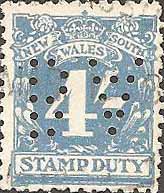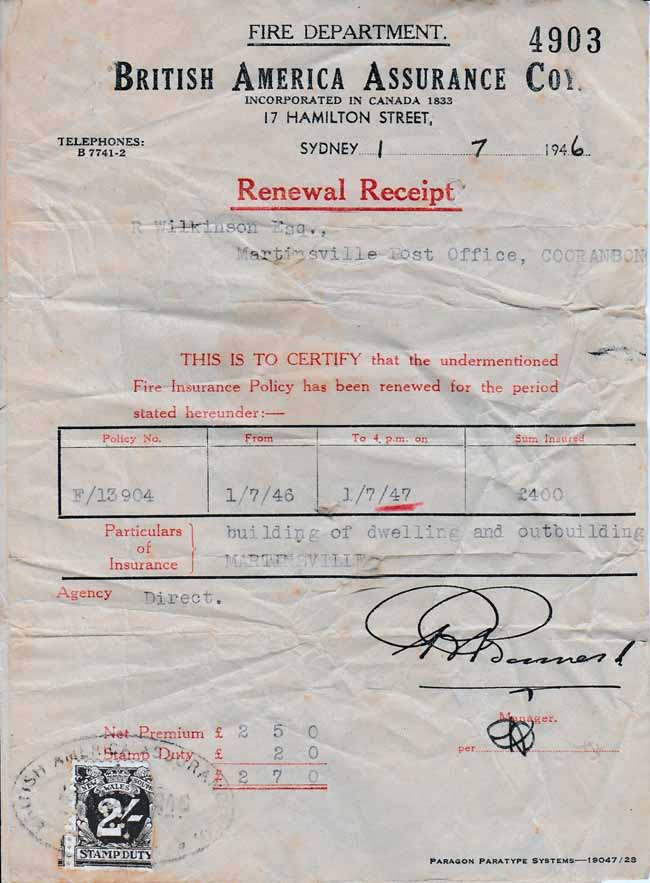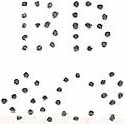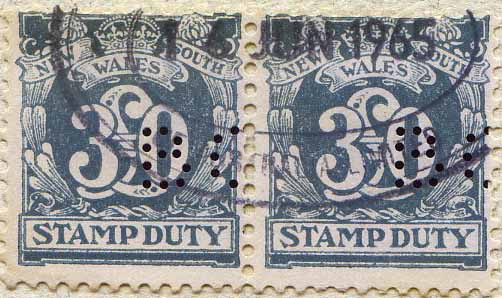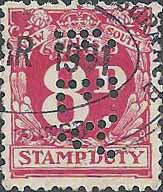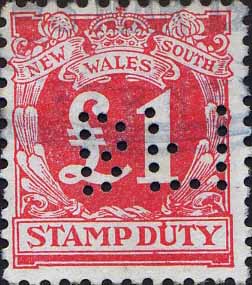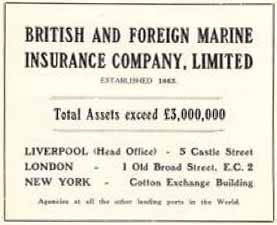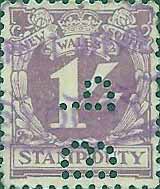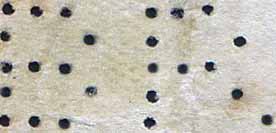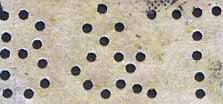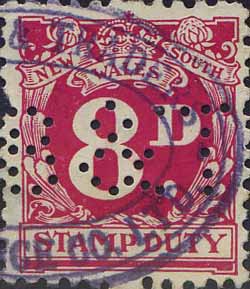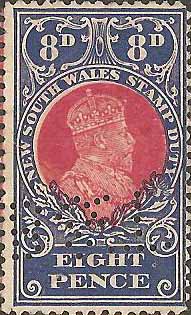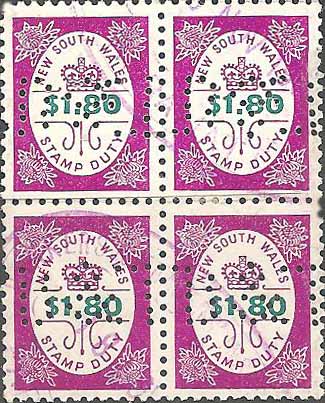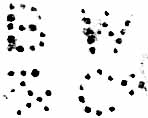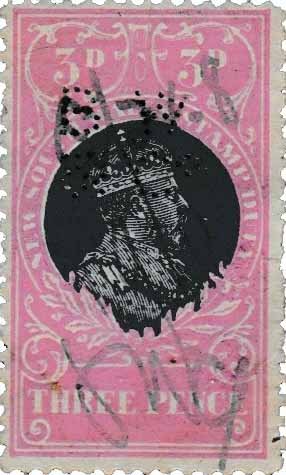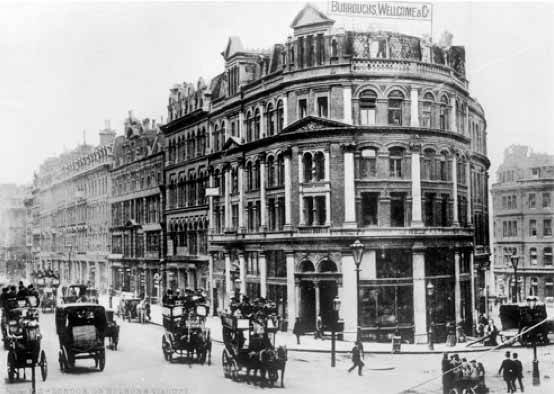|
Private Revenue Perfins of New South Wales An Elsmore Coath production The authors would welcome your comments additions or input into this work A B C D E F G H I J K L M N O P Q R S T U V W Y Other B -------------------------------------------------------- BA.a
User: British America Insurance Co Insurance Provider Address: 15-17 Hamilton St, Sydney, NSW Revenue Use: Numeral 1929-66 issue 1/-, 1/6, 2/-, 4/- Rarity Scale: Numeral 1929-66 issue 1/- R3, 1/6 R4, 2/- R4, 4/- R3 Background: The British America Assurance Co was incorporated in Toronto, Canada in 1833 and despite the name ‘Assurance’, the company was also involved in the sale of a range of ‘Insurance’ products. We are not certain when the company arrived in Sydney, but they had very close ties with fellow Canadian insurer, Western Assurance Company and shared both management and premises. Western are known to have been established in Sydney in the 1930’s. In 1961 Royal Insurance (UK) acquired both the British America Assurance Company and the Western Assurance Company, however the companies continued to trade in their own names. As subsidiaries of Royal Insurance they were absorbed into the RSA Royal Sun Alliance group in the 1990’s Device: The BA.a device is most likely a single die device as it is able to produce single, central strikes in a range of stamp formats. The device is found used on the revenue stamps of NSW but also on the postage stamps of Australia, over the period 1938-1948. As with many Insurance companies the use on revenue stamps continued after the use on postage stamps and revenue use continued until at least 1952. Related Patterns: Refer to related company patterns in: QLD: Other – Section 1 Commercial Perfins and Cancelling Devices Western Assurance Co Ltd WA: WA.a WA/CO.a See also Royal Insurance in NSW RI/Co.a for further related patterns -------------------------------------------------------- B&B.a
User: Brierly & Brierly Chartered Accountants Address: ‘Vickery Chambers’ 76-82 Pitt St, Sydney, NSW Revenue Use: Numeral 1928-66 issue 2d Rarity Scale: Numeral 1928-66 issue 2d R5 Background: *Henry Charles (HC) Brierley was born in 1865 and became the founding partner of Brierley and Brierley, a firm of Accountants in Sydney. Brierly and Brierly were a well respected firm with links to the primary production industry through their involvement with the Flour Mill Owners Association and a series of semi Government appointments as Managing Secretaries to Regional progress societies. Consistent with his role in primary production in 1908 Henry authored (with E.H. Tebbutt) the major reference to the NSW Pure Food Act 1908 entitled ‘The NSW Pure Food Manual’ “The NSW Pure Food Act 1908 had been passed in response to concerns about the general lack of interest in food inspection shown by local councils. The Act gave responsibility for its administration and enforcement to the NSW Board of Health, and came into effect on 1 July 1909 and remained in place until 1989.”Henry took a lead role in the Federal Institute of Accountants serving as Chairman of the NSW Division from 1907 until at least 1932. Henry died in October 1935. Device: The B&B.a device was almost certainly a single die device, as it was able to produce single central strikes in a variety of positions in a range of stamp formats. This device is found used on the revenue stamps and postage stamps of NSW as well the postage stamps of Australia (from 1913) over the period from 1906 until at least 1928. Some previous studies report earlier usage from 1903 but this is not supported by the usage and postmark evidence that we have seen. Revenue use is extremely rare. In the early 1920’s the device started to show signs of disrepair and this is confirmed by the increasing number of consistent missing pins in the ampersand and later the left hand side of the second B. Related Patterns: Nil *Trove -------------------------------------------------------- BB/&Co..a
User: Bosch Barthel & Co Jewellers Address: 196 Pitt St, Sydney, NSW Revenue Use: QV 1880-1902 issue 2d Rarity Scale: QV 1880-1902 issue 2d R4 Background: *George Bosch was born on 18 February 1861 at Osborne's Flat (near Yackandandah), Victoria, the son of German parents who had emigrated to Australia. After leaving school he was apprenticed to a Melbourne watchmaker, but in 1881 he went into partnership in Sydney with his father George, as Bosch & Son, importing watch materials and tools. In 1885 he was joined by Emil Barthel and the business gradually expanded into dental and optical supplies and diamonds. Bosch made his first business visit to Europe in 1885, and being of German decent, speaking German well and through connections to the Hansa Trading network through his mothers’ family, he was well placed to establish some sound business relationships and agencies. In 1894 he bought out Barthel but kept the name, Bosch Barthel & Co. and established branches in Melbourne and Brisbane. The business flourished much as a result of Bosch’s efforts, he was an efficient manager and worked long hours, to the eventual detriment of his health. Bosch also built his wealth through successful investments in stocks and real estate. He shared his wealth with huge contributions to charitable and educational institutions. Bosch retired in 1924 and in retirement he continued his philanthropic activities including a gift of £200,000 in property and securities to the University of Sydney. He also traveled extensively including Europe the USA and Asia. After a visit to East Asia in 1928 his health failed but he was nursed back to good health and on 11 October 1929 (at Beechworth, Victoria), he married 28-year-old Gwendoline Jupp, who had nursed him. Bosch died on 31 August 1934 following a heart attack and was survived by his wife and two sons. Device: The BB/&CO.a device was almost certainly a single die device as it was able to produce single central strikes in a variety of positions in a range of stamp formats. Furthermore multiple strikes that we have seen do not show a consistent relationship to each other. The device is found used on the revenue stamps and postage stamps of NSW as well the postage stamps of Australia (from 1913) over the period from 1902 until at least 1925. However this usage was not contiguous as the early use seems to stop in late 1905 and the later usage does not start until around 1924. The examples of the pattern that we have seen from the end of the early usage (1905) show many missing pins and poorly punctured holes, particularly in the ampersand and the C and this suggests that the device was not in good condition at this stage. When usage restarts in 1924 the ampersand and the C are still generally poorly struck, which indicates that the device was returned to service without being repaired. The timing of the reintroduction of the device in interesting as it seems to coincide with Bosch’s retirement and may have been an additional security measure applied by Bosch himself, but that is speculation. Some previous studies report a pattern BB/CO which is exactly the same as the BB&CO.a pattern with the exception that the ampersand is missing. Notably the BB/CO has a full C and O. This pattern is rare and the examples we have seen date from around 1926. This date suggests that the BB/CO pattern is merely a result of a repair to the BB/CO.a device, perhaps involving the relocation of the few remaining working pins in the ampersand to replace the pins missing in the C and O. In any case the BB/CO pattern is short lived and further it is not reported on revenue stamps. Related Patterns: Nil *Australian Dictionary of Biography *Wikipedia -------------------------------------------------------- BC.a
User: British Commonwealth Insurance Co Ltd Insurance Provider Address: ‘Temple House’ 2 Bligh St, (Cnr Bent & Bligh Sts), Sydney, NSW Revenue Use: Numeral 1929-66 issue 3d, 9d, 1/6, 5/-, 6/-, 10/-, £1, 30/-, £5, £10, £30, £50 Decimal 1966 issue 3c, 60c, $1, $3 Rarity Scale: Numeral 1929-66 issue 3d R3, 9d R3, 1/6 R3, 5/- R3, 6/- R2, 10/- R2, £1 R2, 30/- R3, £5 R3, £10 R3, £30 R4, £50 R4 Decimal 1966 issue 3c R4, 60c R4, $1 R4, $3 R4 Background: The British Commonwealth Insurance Co. Ltd. was incorporated in London in 1946 initially as a provider of marine insurance services, however the company had strong ties with the Legal and General Assurance Society Ltd. By 1949 British Commonwealth Insurance had an office in Melbourne (422 Little Collins St.) and later Sydney where from 1959 they were collocated with Legal and General in their premises at 'Temple House' at 2 Bligh St on the corner of Bent St. In 1960 the Legal and General Assurance Society Limited gained full control of The British Commonwealth Insurance Co. Ltd, but the company continued to trade under its own name as a subsidiary. They remained at ‘Temple House’ until 1981 when Legal and General moved to a new office tower at Milsons Point. Device: The BC.a device is multi die device most likely in a horizontal array of 3 dies. It is similar in structure and font to the LG.a and G.a devices of the sister companies Legal and General and Gresham Fire and Accident Insurance. The evidence for multi dies comes from the consistent relationship between strikes on stamps with multiple strikes. The case for 3 dies is based on the fact that this was a popular format for patterns of similar style and fonts and therefore likely the same manufacturer. The dies are essentially the same and accordingly we have listed it as a single pattern. The pattern is only found used on the revenue stamps of NSW and then only in the period from 1959 until 1966. Late usages in 1965-66 sometimes carry cachets of 'The Co operative Assurance Co of Australia Limited'. Related patterns: Refer to other Legal & General related company patterns in:
NSW: CIC.a G.a LG.a -------------------------------------------------------- BEA.a
User: British Equitable Assurance Co Ltd Insurance Providers Address: 75-77 Pitt St, Sydney, NSW Revenue Use: Numeral 1929-66 issue 8d Rarity Scale: Numeral 1929-66 issue 8d R4 Background: The British Equitable Assurance Company was established in the 1800’s but was only restructured as an incorporated body as The British Equitable Assurance Company Ltd in London in July 1903.
In Australia they had established offices in Melbourne in March 1882 but they did not open a Sydney office until June 1906, although they had agencies in operation prior to this date.
British Equitable where acquired by State Assurance Company in 1924 and later this company was in turn acquired by the Royal Exchange Assurance group. The Royal Exchange Assurance group operated in its own right and also traded through a number of subsidiary companies in Australia including the State Assurance Co. Ltd., British Equitable Assurance Co. Ltd., Java Sea and Fire Insurance Co. Ltd., Congregational Insurance Co. of Australia Ltd., Australia of the Sea Insurance Co. Ltd., Fire and Accident Insurance Co. of Australasia Ltd. and the Batavia Sea and Fire Insurance Co. Ltd. later renamed 'Australian and Eastern Insurance Co. Ltd'.
In 1968 Royal Exchange Assurance combined with the Guardian Assurance Company Limited to form Guardian Royal Exchange Assurance and in 1999 this group was acquired by the French Insured AXA. In 2011 AXA's Australian, New Zealand and Asia Pacific interests were accquired by APM. Device: The BEA.a device was only in use for a very short period of time around 1931 and very few examples are known. It is only found used on the revenue stamps of NSW. The structure of the BEA.a device is very similar to that of the REA.a device. (See REA.a in this chapter). In two articles in the South Pacific Perfin Bulletin (#27 & #45) it has been suggested that the BEA.a device was modified to become the REA.a device. This is possible as the two patterns share almost all the same pin locations. The problem with this scenario is the chronology of the usage of the devices with usage of REA.a (1926-1930) preceding the use of BEA.a (1931). If this is the case then the BEA.a device was purchased, but not used by the Company and then it was altered to become the REA.a device in 1926. Then around the time that the REA.b device replaced the REA.a device (early 1930’s) the REA.a device was returned to its original form and used briefly as BEA.a. Alternatively, and somewhat more logically, given the chronology of the BEA.a and REA.a and .b devices, the BEA.a device was formed from a modification of the REA.a device which proved unsuccessful as it was only used for a very short period. Related Patterns: Refer to other Atlas, Royal Exchange and related company patterns in: NSW: A.a A.b A.c A.d GAC.a REA.a REA.b SAC.a Other – Section 2 Commercial Overprints A(Atlas).a Royal/Exchange/Assurance.a State/Assurance/Co Ltd.a QLD: A.a -------------------------------------------------------- BFI.a
User: British & Foreign Marine Insurance Co Insurance Provider Address: 16 Spring St, Sydney, NSW Revenue Use: Numeral 1929-66 issue 3d, 9d, 1/-, 2/6, 14/-, £1 Rarity Scale: Numeral 1929-66 issue 4d R3, 9d R3, 1/- R2, 2/6 R4, 14/- R4, £1 R4 Background: *The British and Foreign Marine Insurance Company Limited was formed in Liverpool in 1863 to address the shortfall in providers of Marine insurance. The Articles of Association of the company limited their activities to the ‘cargo and freight’ being carried by ships rather than the ships themselves. This limited the companies customer base so the Board created a sister company the ‘Mercantile Marine Insurance Company Limited’ to underwrite the ‘hulls’ associated with the cargo that was covered by British and Foreign. With this structure the company grew quickly establishing agencies in India, China, East Asia, Canada, Cape of Good Hope Colony as well as Australia (Melbourne). Later they expanded into Europe and the US and by the start of the 20th century they were a truly global provider. In 1893 they acquired the Universal Marine Insurance Company which had already established branches in Australia, Melbourne (1860’s), Sydney (1870) and Brisbane (1876). This was later augmented by the acquisition of the small Australian company the Southern Insurance Company in 1898. In 1909, after lengthy discussions, British and Foreign were acquired by the large English insurer, Royal Insurance, who did not have an interest in marine or freight underwriting. For this reason British and Foreign and their subsidiary companies around the world continued to trade as British and Foreign. Such acquisitions became commonplace in the insurance sector during the 20th century and often companies acquired by larger firms continued to trade as separate entities, but did so from 'composite' offices. In 1919 Royal acquired the global insurer Liverpool London and Globe, in what was at the time the largest merger in British Insurance history. This merger and acquisition trend continued with the acquisition of London and Lancashire Insurance (1961) and culminating in Royals merger with Sun Alliance, itself a product of mergers between the Sun, Alliance, London and later Phoenix Insurance companies. The resulting company Royal Sun Alliance was formed in 1996 and was later (2008) rebadged as RSA Insurance Group and is headquartered in London. As part of these changes the companies activities in Australia and New Zealand are restructured under the Promina Brand and the General Insurance arm is renamed Vero.
Device: The BFI.a device was most likely a single die device and is found used on the revenue stamps of NSW and the postage stamps of Australia over the period 1942 until at least 1959. The company also had a device located at their Melbourne head office which produces a similar, but slightly larger pattern, but it is not found used on revenue stamps. Related Patterns: Refer to Royal Insurance patterns in RI/Co. *The British and Foreign Insurance Company Limited 1863-1963, published by Rockliff Bros. Ltd, Liverpool. -------------------------------------------------------- BP.a
User: Burns Philip and Company Ltd
Shipping, Coastal/Island Trading and Retail
Address: 7 Bridge St, Sydney, NSW Revenue Use: Numeral 1929-66 issue 2d, 1/- Rarity Scale: Numeral 1929-66 issue 2d R3, 1/- R4 Background: *James Burns (later Sir James) arrived in Australia from Scotland in 1862 and after being involved in his brother’s retail business in Brisbane he moved to Townsville and established his own retail/wholesale business in 1872. In 1874 he met another Scottish immigrant, Robert Philip, who he later took as a partner. In 1882 the partnership was converted into a corporation and Burns Philip and Company Ltd was formed.
Burns Philip’s interests expanded to include coastal trading and shipping, around Australia and into much of the South Pacific. This necessitated the establishment of many remote offices, some of which were provided with perforators.
Device: The BP.a device is most likely a single die device and it is found used on the revenue and poatage stamps of NSW, but also on the postage stamps of Australia (from 1913). Usage on postage stamps is over a long period from at least 1908 until 1954, but usage on revenues is much less common and seems to be restricted to the 1930’s.
In previous studies of Australian perfins it has been reported that this device was a 2 die device. This is not the case as the device can produce single central strikes in stamps of a variety of formats. The report is most likely caused by confusion with some of the similar and less common BP devices used in North Queensland.
Related Patterns: Refer to other Burns Philip patterns in: NSW: B&T.a N.Q/I.Co.a Q.I/Co.a QLD: BP.a BP.b BP.c BP.d *Australian Dictionary of Biography
-------------------------------------------------------- BR.a
User: BR (Unknown) Railway Use: QV 1890-1929 issue1/- Rarity Scale: QV 1890-1929 issue 1/- R4 Background: Unknown. Device: The BR.a device is peculiar in that it is a service puncture device. That is a device which can be set up to produce a temporary die to puncture a number of stamps at a given time. The setting on these dies is generally not retained and this means that when the temporary die is reset the next time it is required, there can be variation in the location of the pins. Thus producing a slightly different pattern, in particular in terms of the spacing between letters and in some instances the structure of the letters themselves. These service puncture devices were popular in Melbourne, Victoria from about 1893 until around 1910 but their use continued into the late 1920’s. The patterns from these devices are responsible for over 70% of the total perfin patterns found on Australian stamps. The structure of these devices was a single die format. The owners of these dies were generally stamp vendors who sold postage stamps and added a customers company initials as a bundled or value added service. Sydney use of these devices is rare and this is the only example that the authors have ever seen on a railway stamp. The BR.a pattern is found on the postage stamps of NSW in the period around 1905. Usage has been reported from as early as 1896 but this is not supported by the examples that we have seen. There are at least two forms of this pattern, one with the letters nearly touching and the other with a slight separation. This is an example of the form in which there is a slight separation and this is the more common form. Related Patterns: Nil -------------------------------------------------------- B&T.a
User: Bankers & Traders Insurance Co Ltd
Insurance Provider
Address: 48-52 Pitt St, Sydney, NSW (Refer to the background for additional locations) Revenue Use: KEDVII 1909-28 issue 8d, 1/-, 3/- Numeral 1917-28 issue 2d Numeral 1929-66 issue 2d, 3d, 4d, 6d, 8d, 9d, 1/-, 1/6, 2/-, 2/6, 3/-, 4/-, 5/-, 6/-, 8/-, 10/-, 12/-, 14/-, 16/-, £1, 30/-, £1 Decimal 1966 2c, 3c, 8c, 10c, 15c, 20c, 80c, $1, $1.60, $1.80, $2, $3, $10 Rarity Scale: KEDVII 1909-28 issue 8d R4, 1/- R3, 3/- R4 Numeral 1917-28 issue 2d R4 Numeral 1929-66 issue 2d R3, 3d R1, 4d R3, 6d R1, 8d R3, 9d R1, 1/- R1, 1/6 R3, 2/- R3, 2/6 R2, 3/- R3, 4/- R3, 5/- R2, 6/- R2, 8/- R4, 10/- R2, 12/- R4, 14/- R4, 16/- R4, £1 R2, 30/- R1, £5 R4 Decimal 1966 2c R4, 3c R4, 8c R4, 10c R2, 15c R4, 20c R1, 80c R4, $1 R4, $1.60 R4, $1.80 R3, $2 R3, $3 R4, $10 R4 Background: *The Bankers and Traders Insurance Company was founded by Sir James Burns, of Burns Philip fame and was incorporated in Sydney in March 1921. Burns was the founding Chairman but when he died in 1923 his son James took over the position. Burns had previously launched the North Queensland (later Queensland) Insurance company to underpin his marine business, but Bankers and Traders was started and named to reflect the 'Trading' companies, such as what Burns Philip had developed into and 'Bankers' to reflect the support the venture received from the Montreal Trust Company, which was a division of the Royal Bank of Canada. The company was initially located at 48-52 Pitt St, Sydney in the Queensland Insurance Building and many resources, including key staff were borrowed from the sister company to allow B&T to flourish. By early 1922 the company had offices in NSW, South Australia, Western Australia and London as well as 11 other agencies throughout the Asia Pacific. Growth continued and by the end of the 1920’s the company had added offices in Melbourne (1923), Tasmania (1926) as well as 12 new overseas agencies including expansion into Canada. The company expanded its branches through regional Australia in most major centres and by the late 1930’s occupied offices in the MLC Building at 44 Martin Place, Sydney. In 1940 the company secured Stanton House at 131-133 Pitt St, a building they were to occupy until the completion of their new headquarters at 115 Pitt St, in 1971. In 1973 Bankers and Traders joined with Queensland Insurance and subsidiary the Equitable Probate and General Insurance Co. Ltd to form QBE Insurance. Device: The B&T.a device was most likely a single die device as multiple strikes do not show any consistent relationship to each other. The B&T.a device is found used on the revenue stamps of NSW as well as the postage stamps of Australia from as early as 1927, more than likely earlier, and it remained in service until at least 1966. As with many other Insurance company users the use on postage stamps was discontinued earlier. With respect to the B&T.a device it ceased being used on postage stamps in around 1948.
The die of the B&T.a device is quite wide and for this reason it is quite often seen as a partial or incomplete strike. Early in its use the device develops a consistent missing pin in the centre of the B, which makes the B look more like D.
Related Patterns: Refer to other Burns Philip Insurance Company patterns in: NSW: BP.a N.Q/I.Co.a Q.I/Co.a QLD: BP.a BP.b BP.c BP.d For more Burns Philip patterns see NSW BP.a *QBE website
*’The First 50 Years’ 1972 self published by the Bankers and Traders Insurance Company Limited.
-------------------------------------------------------- BW/&Co.a
User: Burroughs Wellcome & Co Address: 481 Kent St, Sydney, NSW Revenue Use: KEVVII 1908 Series 3d Rarity Scale: KEDVII 1908 Series 3d R5 Background: *Burroughs Wellcome was established in London in 1880 by Henry Wellcome (later Sir) and Silas Burroughs. Their they setablished a pharmaceutical company, which would become a global driver of product innovation and research. The company employed a technique of crushing and reforming graphite that had been invented to improve the quality of ‘lead’ pencils. This process was much more efficient that the pestle-and-mortar method which was currently used to prepare medicines. This allowed them to make medicines in the form of compressed pills which they marketed throughout the world. In 1883, the company acquired larger offices in Snow Hill, London, and this remained their headquarters for nearly 60 years, until they were destroyed during the Blitz in 1941.
Head Office, Burroughs Wellcome & Co. Snow Hill, London, 1880s In 1888, Wellcome, working with a team of engineers designed an even better manufacturing process and this increased their production rate to 600 compressed pills per minute, which was well ahead of their competitors. The company then went on to establish a powerful brand name for their products by coining the term, ‘Tabloid’, a word he created by joining the words 'tablet' and 'alkaloid'. The word came to describe the purity and accuracy of Burroughs Wellcome products. The name was later applied to the full range of the company's products, including first aid kits and medicine chests, the photographic developer and even tea. The term has now passed into general use to mean anything in compact form, in particular a condensed newspaper format. Silas Burroughs died in 1895 and full control of the business passed to Wellcome who undertook a massive expansion for the company, with the first overseas branch opening in Sydney in 1898. By 1912 the company had opened offices in New York, Montreal, Buenos Aires, Cape Town, Milan, Shanghai and Bombay. The success of the company was initially underpinned by their pill making technology but it grew based on its pioneering research laboratories in England and abroad. In the 1920’s they expanded into vitamin and other supplements. In 1924, Wellcome consolidated all of the company’s holdings, both in England and abroad, under a corporate umbrella that he named The Wellcome Foundation Ltd. The focus of the Foundation was business based but it included other philanthropic activities such as building museums, libraries, and numerous research projects on several continents. This was acknowledged by many honours, including a knighthood received in 1932. Through a series of mergers and acquisitions beginning in the 1980’s Burroughs Welcome were absorbed into the Glaxo Wellcome Group, which, then merged with Smith Kline Beecham to form Glaxo Smith Kline in December 2000. Device: This pattern has been reported on NSW railway parcel stamps but no example has been seen by the authors. This is not unlikely given the general scarcity of perfins on railway stamps. If anyone has an example we would appreciate a scan so that we can comfirm its existance and share it with collectors. The BW/CO.a device is found used on the postage stamps of NSW and later those of Australia, (from 1913) from as early as 1906 until at least 1933. The pattern is also reported on the postage stamps of South Australia and Queensland but this is likely to be restricted to the 1912 period when there was cross State usage, mainly in Sydney, as the Postmaster General sought to use up stocks of States stamps prior to issuing the Kangaroo series in 1913. The device was most likely a single die format and it had quite fine pins, late usage shows many missing pins which makes identification difficult. The company had an office in Melbourne and this office has a 2 die Sloper device which produced a similar but larger pattern. These are not reported on revenue stamps. Related patterns: Nil -------------------------------------------------------- A B C D E F G H I J K L M N O P Q R S T U V W Y Other © copyright 2011 |

